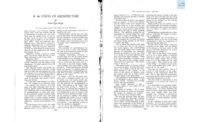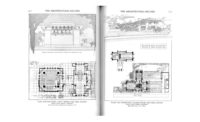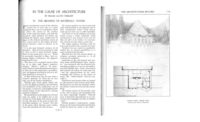I have observed that Nature usually perfects her forms; the individuality of the attribute is seldom sacrificed, that is, deformed or mutilated by cooperative parts. She rarely says a thing and tries to take it back at the same time. She would not sanction the "classic" proceeding of say, establishing an "order," a colonnade, then building walls between the columns of the order reducing them to pilasters, thereafter cutting holes in the wall and pasting on cornices with more plasters around them, with the result that every form is outraged, the whole an abominable mutilation, as is most of the architecture of the Renaissance wherein style corrodes style and all the forms are stultified.
In laying out the ground plans for even the more insignificant of these buildings, a simple axial law and order and the ordered spacing upon a system of certain structural unit definitely established for each structure. In accord with its scheme of practical construction and aesthetic proportion, is practiced as an expedient to simplify the technical difficulties of execution, and, although the symmetry may not be obvious, always the balance is maintained. The plans are as a rule much more articulate than is the school product of the Beaux Arts. The individuality of the various functions of the various features is more high developed, all the forms are complete in themselves and frequently do duty at the same time from within and without as decorative attributes of the whole. This tendency to greater individuality of the parts emphasized by more and more complete articulation will be seen in the plans for Unity Church, the cottage for Elizabeth Stone at Glencoe, and the Avery Coonley house in process of construction at Riverside, Illinois. Moreover, these ground plans are merely the actual projection of a carefully considered whole. The "architecture" is not "thrown up" as an artistic exercise, a matter of elevation from a preconceived ground plan. The schemes are conceived in three dimensions as organic entities, let the picturesque perspective fall how it will. While a sense of the incidental perspectives the design will develop is always present, I have great faith that if the thing is rightly put together in true organic sense with proportions actually right the picturesque will take care of itself. No man ever built a building worthy the name of architecture who fashioned it in perspective sketch to his taste and then fudged the plan to suit. Such methods produce mere scene-painting. A perspective may be a proof but it is no nurture.
As to the mass values of the buildings the aesthetic principles outlined in proposition III will account in a measure for their character.
In the matter of decoration the tendency has been to indulge it less and less, in many cases merely providing certain architectural preparation for natural foliage or flowers, as it is managed in, say, the entrance to the Lawrence house at Springfield. This use of natural folia and flowers for decoration is carried to quite an extent in all the designs and, although the buildings are complete without this efflorescence, they may be said to blossom with the season. What architectural decoration the buildings carry is not only conventionalized to the point where it is quiet and stays as a sure foil for the nature forms from which it is derived and with which it must intimately associate, but it is always of the surface, never on it.
The windows usually are provided with characteristic straight-line patterns absolutely in the flat and usually severe. The nature of the glass is taken into account in these designs as is also the metal bar used in their construction, and most of them are treated as metal "grilles" with glass inserted forming a simple rhythmic arrangement of straight lines and squares made as cunning as possible so long as the result is quiet. The aim is that the designs shall make the best of the technical contrivances that produce them.
In the main the ornamentation is wrought in the warp and woof of the structure. It is constitutional in the best sense and is felt in the conception of the ground plan. To elucidate this element in composition would mean a long story and perhaps a tedious one, though to me it is the most fascinating phase of the work, involving the true poetry of conception.
The differentiation of a single, certain simple form characterizes the expression of one building. Quite a different form may serve for another, but from one basic idea all the formal elements of design are in each case derived and held well together in scale and character. The form chosen may flare outward, opening flower-like to the sky, as in the Thomas house; another, droop to accentuate artistically the weight of the masses; another be noncommittal or abruptly emphatic, or its grammar may be deduced from some plant form that has appealed to me, as certain properties in line and form of the sumach were used in the Lawrence house at Springfield; but in every cue the motif is adhered to throughout so that it is not too much to say that each building aesthetically is cut from one piece of goods and consistently hangs together with an integrity impossible otherwise.
In a fine-art sense these designs have grown as natural plants grow, the individuality of each is integral and as complete as skill, time, strength, and circumstances would permit.
The method in itself does not of necessary produce a beautiful building, but it does provide a framework as a basis which has an organic integrity, susceptible to the architect's imagination and at once opening to him Nature's wealth of artistic suggestion, ensuring him a guiding principle within which he can never be wholly false, out of tune, or lacking in rational motif. The subtleties, the shifting blending harmonies, the cadences, the nuances are a matter of his own nature, his own susceptibilities and faculties.
But self-denial is imposed upon the architect to a far greater extent than upon any other member of the fine art family. The temptation to sweeten work, to make each detail in itself lovable and expressive is always great, but that the whole may be truly eloquent of its ultimate function restraint is imperative. To let individual elements arise and shine at the expense of final repose is, for the architect, a betrayal of trust for buildings are the background or framework for the human life within their walls and a foil for the nature efflorescence without. So architecture is the most complete of conventionalizations and of all the arts the most subjective except music.
Music may be for the architect ever and always a sympathetic friend whose counsels, precepts, and patterns even are available to him and from which he need not fear to draw. But the arts are today all cursed by literature; artists attempt to make literature even of music, usually of painting and sculpture and doubtless would of architecture also were the art not moribund; but whenever it is done the soul of the thing dies and we have not art but something far less for which the true artist can have neither affection nor respect.
Contrary to the usual supposition this manner of working out a theme is more flexible than any working out in a fixed, historic style can ever be, and the individuality of those concerned may receive more adequate treatment within legitimate limitations. This matter of individuality puzzles many; they suspect that the individuality of the owner and occupant of a building is sacrificed to that of the architect who imposes his own upon Jones, Brown, and Smith alike. An architect worthy of the name has an individuality, it is true; his work will and should reflect it, and his buildings will all bear a family resemblance one to another. The individuality of an owner is first manifest in his choice of his architect, the individual to whom he entrusts his characterization. He sympathizes with his work; its expression suits him, and this furnishes the common ground upon which client and architect may come together. Then, if the architect is what he ought to be, with his ready technique he conscientiously works for the client, idealizes his client's character and his client's tastes, and makes him feel that he building is his as it really is to such an extent that he can truly say that he would rather have his own house than any other he has ever seen. Is a portrait, say by Sargent, any less a revelation of the character of the subject because it bears his stamp and is easily recognized by anyone as a Sargent? Does one lose his individuality when it is interpreted sympathetically by one of his own race and time who can know him and his needs intimately and idealize them, or does he gain it only by having adopted or adapted to his condition a ready-made historic style which is the fruit of a seedtime other than his, whatever that style may be?
The present industrial condition is constantly studied in the practical application of these architectural ideals and the treatment simplified and arranged to fit modern processes and to utilize to the best advantage the work of the machine. The furniture takes the clean-cut, straight-line forms that the machine can render far better than would be possible by hand. Certain facilities, too, of the machine, which it would be interesting to enlarge upon, are taken advantage of and the nature of the materials is usually revealed in the process.
Nor is the atmosphere of the result in its completeness new and hard. In most of the interiors there will be found a quiet, a simple dignity that we imagine is only to be found in the "old" and it is due to the underlying organic harmony, to the each in all and the all in each throughout. This is the modern opportunity to make of a building, together with its equipment, appurtenances, and environment, an entity which shall constitute a complete work of art, and a work of art more valuable to as a whole than has before existed because discordant conditions endured for centuries are smoothed away; everyday life here finds an expression germane to its daily existence: an idealization of the common need sure to be uplifting and helpful in the same sense that pure air to breathe is better than air poisoned with noxious gases.
An artist's limitations are his best friends. The Machine is here to stay. It is the forerunner of the democracy that is our dearest hope. There is no more important work before the architect now than to use this normal tool of civilization to the best advantage instead of prostituting it as he has hitherto done in reproducing with murderous ubiquity forms both of other times and other conditions and which it can only serve to destroy.








Post a comment to this article
Report Abusive Comment